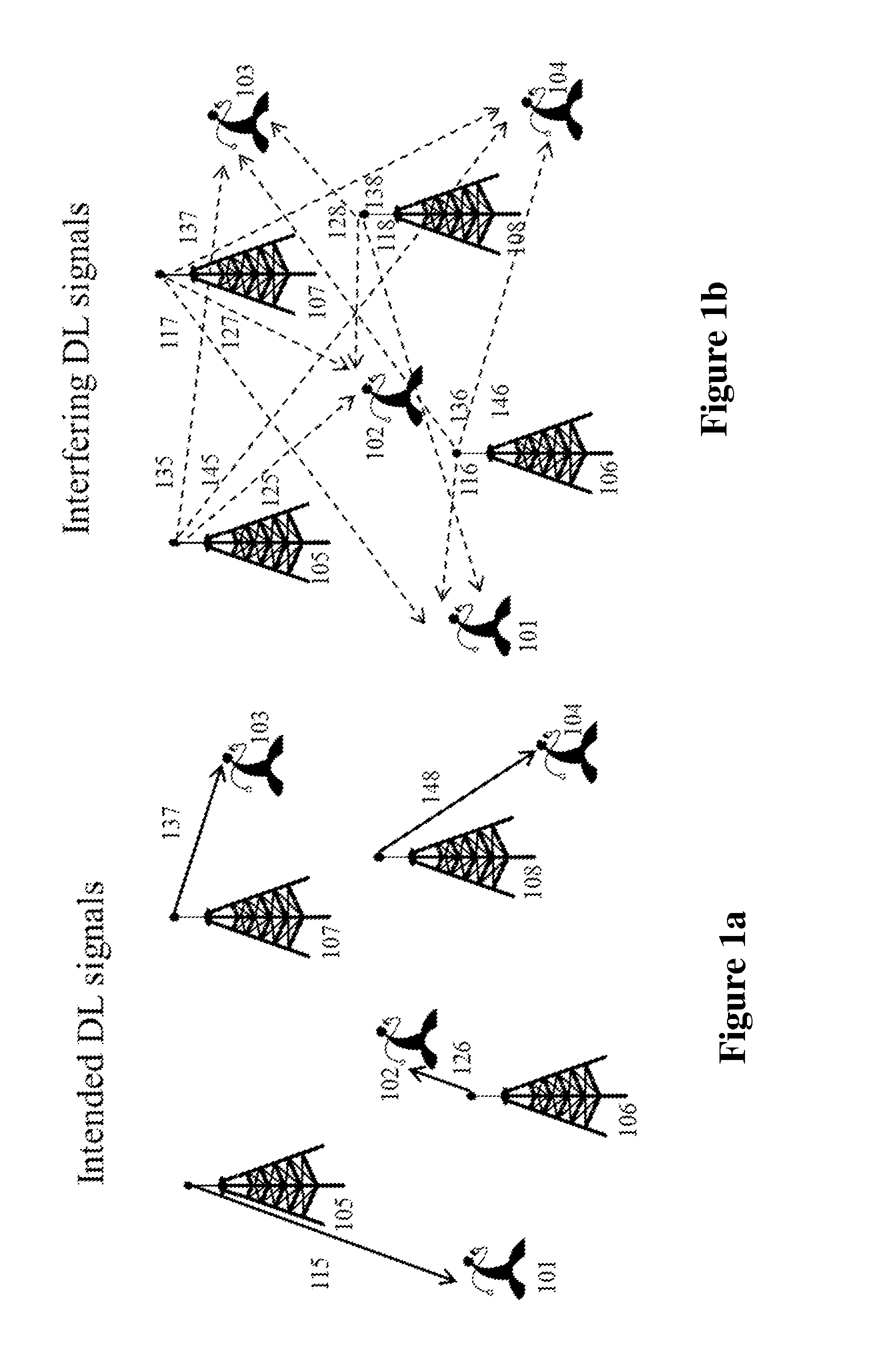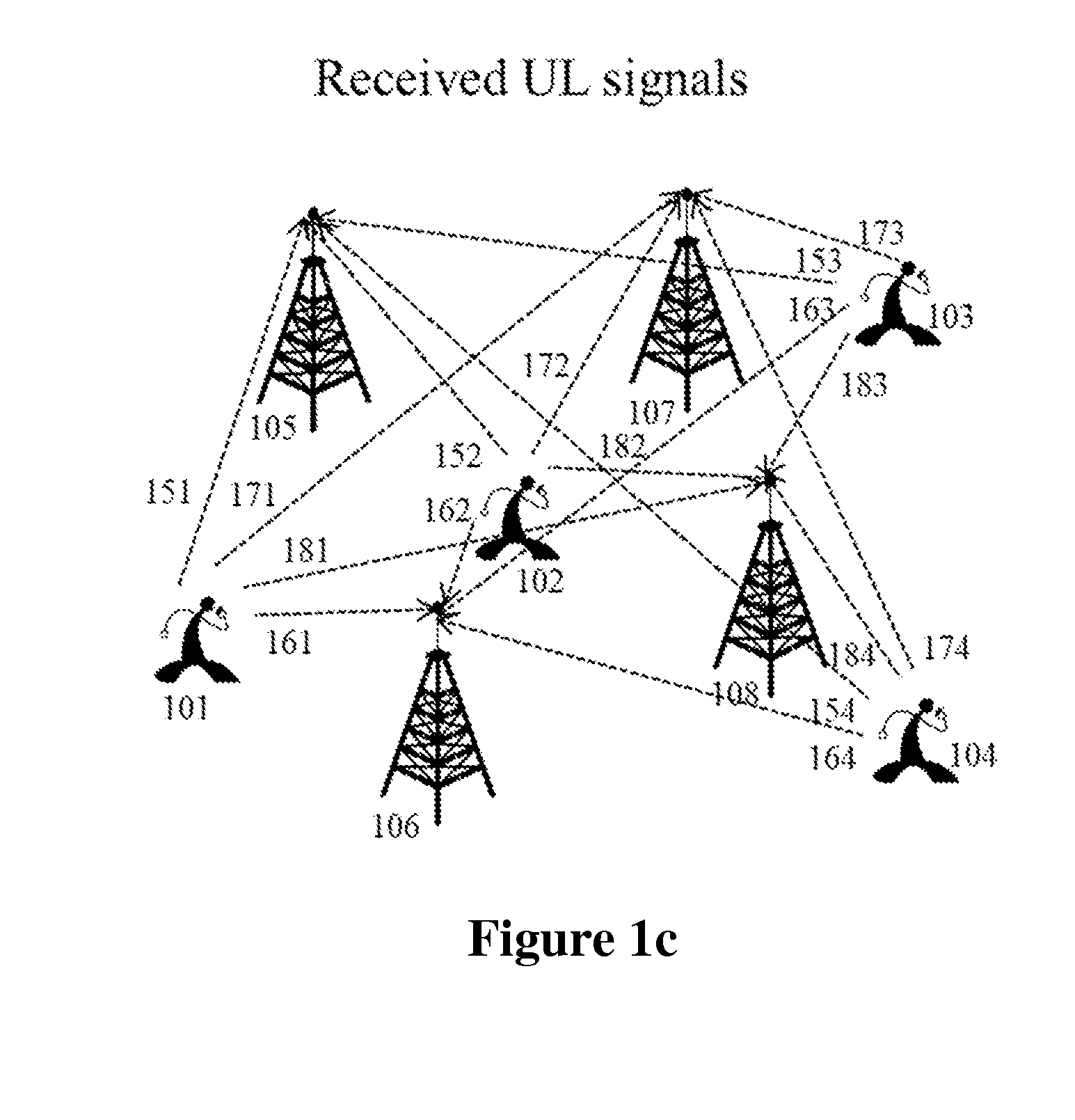Method and systems for decentralized interference management in a multi-antenna wireless communication system
a wireless communication system and interference management technology, applied in the field of wireless communications, can solve the problems of affecting the overall potential gain, the complexity of the solution scales with the number, and the optimal transmit/receive strategy of linear spatial filters that maximize the weighted sum of data rates of the system is not known
- Summary
- Abstract
- Description
- Claims
- Application Information
AI Technical Summary
Benefits of technology
Problems solved by technology
Method used
Image
Examples
embodiment 1
[0105]The knowledge of the interference cost matrix γi, (0), at BSi allows managing the interference created by BSi towards unintended UEs attached to other BSs.
[0106]In this regard, FIG. 2 illustrates how the DL transmit and receive filters are designed in a deployment with 2 BSs and 1 UE attached to each BS. First, each BSi designs its DL transmit filter Ti (along with Ri) based on the equation (0), using the knowledge of the channel matrix towards its associated UE Hi,i (201, 208), the weighting matrix Wi (203, 210) and an estimation of the interference cost matrix {circumflex over (γ)}i (202, 209). The design is done by solving the decentralized optimization problem in (0) (or one of the extended versions in (0), (0), (0) or (0)) with γi={circumflex over (γ)}i (204, 211). Then, the DL receive filter Ri is computed at each UEi (205, 212) by means of equation Error! Reference source not found.(0) based on the knowledge of the equivalent complex channel matrix towards its associate...
embodiment 2
[0115]FIG. 6 illustrates the block diagram corresponding to Embodiment 2 as applied to a wireless cellular communication system. First, each base station BSi acquires or updates the knowledge of the complex channel matrix towards its own UEi Hi,i (601), which contains the channel gains between each UE antenna element and each BS antenna element. The channel state acquisition can be done either at the BS by exploiting channel reciprocity or at the UE and then reported to the BS. Once this information is available at BSi, the DL transmit and receive filters are calculated in a decentralized manner as it is described in Embodiment 1 and FIG. 2, and DL data transmission is carried out (602). Based on the knowledge of the DL receive filter at each UE, the UL transmit filter is designed as it is described in Embodiment 1 and FIG. 3 (603) and an UL non-data transmission is carried out (604). The UL non-data transmission by non-associated UEj allows BSi to estimate the interference cost mat...
embodiment 3
[0117]FIG. 7 illustrates the block diagram corresponding to Embodiment 3 as applied to the DL of a wireless cellular communication system. First, each base station BSi acquires or updates the knowledge of the complex channel matrix towards its own UEi Hi,i (701), which contains the channel gains between each UE antenna element and each BS antenna element. The channel state acquisition can be done either at the BS by exploiting channel reciprocity or at the UE and then reported to the BS. Once this information is available at BSi, the DL transmit filters are calculated in a decentralized manner as it is described in Embodiment 1 and FIG. 2, and DL non-data transmission is carried out (702). Based on the knowledge of the received interference-plus-noise at each UE, the UL transmit filter is designed as it is described in Embodiment 1 and FIG. 3 (703) and an UL non-data transmission is carried out (704). The UL non-data transmission allows BSi to estimate the interference cost matrix b...
PUM
 Login to View More
Login to View More Abstract
Description
Claims
Application Information
 Login to View More
Login to View More - R&D
- Intellectual Property
- Life Sciences
- Materials
- Tech Scout
- Unparalleled Data Quality
- Higher Quality Content
- 60% Fewer Hallucinations
Browse by: Latest US Patents, China's latest patents, Technical Efficacy Thesaurus, Application Domain, Technology Topic, Popular Technical Reports.
© 2025 PatSnap. All rights reserved.Legal|Privacy policy|Modern Slavery Act Transparency Statement|Sitemap|About US| Contact US: help@patsnap.com



